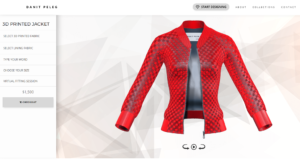Lace isn’t just for wedding dresses or your grandmother’s doilies anymore, especially not when 3D printing is involved. Researcher Lushan Sun recently presented her case study about a 3D printed garment, titled “Instilled: 3D Printing Elastic Lace,” at the International Textile and Apparel Association (ITAA) Annual Conference Proceedings.
Many designers are experimenting with the use of 3D printing in customized apparel design, in order to solve aesthetic issues as well as creating a unique design that’s also functional. While some designers, like Continuum Fashion with its N12 bikini, use SLS technology to create articulating structures for clothing, others, such as Israeli fashion designer Danit Peleg, use FDM and more flexible materials to make pieces that are actually comfortable to wear.“The purpose of this design study is to explore the elastic performance in the various 3D printed structures using flexible FDM filament (nylon) in ready to wear apparel,” Sun wrote in her paper. “The goal is also to explore visual illusion in surface design through digital textile printing. Research through design (RTD) methodology was applied in this case study, and data were collected through reflexive journal documentation, video recording of the virtual design process.”
This second was the route that Sun took for the study, which focused on the “inspiration of visual illusion.” Sun integrated organic forms, which fused together to look like lace, in the prototype garment, which featured a delicate torso and skirt portion, completed with a flared silk skirt with an uneven hemline. The torso part of the dress, which blends two digital design applications, was lined with silk habotai – one of the most basic plain weaves of silk fabric – and did not require an additional closure in the form of a zipper.
“The torso was developed in silk charmeuse and consists of a stylized neckline and waistline. The back consists of two layers, a stylized cowl neckline and a 3D printed portion (nylon in FDM). The silks are draped over the elastic 3D printed lace to juxtapose the loosely fitted and the form-fitted silhouettes,” Sun wrote.
“Overall, the organic engineered print and 3D printed lace patterns in the front and back help to provide a unique focal point from different angles of the garment.”
There were four important phases in the development of the dress. First, Sun explored and sampled the chosen engineered textile prints in order to work out the appearance and color schemes, using Adobe to generate graphics for rendering and manipulation. Draping techniques were then used to develop flat patterns for the flowing piece.
The third step consisted of using direct 3D modeling techniques in Rhino to fully reflect the style of the dress’s organic shapes.
Sun explained, “The units were repeated to form the various groupings that were sampled for different elastic performance.”
 The shapes in the lace-like, 3D printed part of the garment, which is fitted to the waist, upper hip, and shoulder, were customized to the shape of the flat pattern, in addition to being engineered to different scales so they would fit both the elastic and aesthetic needs of the dress. Finally, Sun used commercial Rit dye to give the 3D printed part of the garment the same ombre transitioning color scheme that the textile portions had.
The shapes in the lace-like, 3D printed part of the garment, which is fitted to the waist, upper hip, and shoulder, were customized to the shape of the flat pattern, in addition to being engineered to different scales so they would fit both the elastic and aesthetic needs of the dress. Finally, Sun used commercial Rit dye to give the 3D printed part of the garment the same ombre transitioning color scheme that the textile portions had.
“The resulting garment prototype takes the advantage of engineered elastic performance of the 3D printed lace in form fitting,” Sun concluded.
“This case study also suggested some challenges exist in developing a resilient and flexible structure that is both comfortable and durable in wearing. Future research should consider alternative 3D printed structures through difference 3D modeling techniques. Additionally, alternative complexity can be considered in the structure with different FDM materials.”
I can honestly say, without a doubt, that this is one of my favorite 3D printed pieces of clothing. I would definitely wear this dress out and about, as it looks comfortable enough to spend a decent amount of time in…pair it with some 3D printed high heels and I’m out the door!
What do you think? Discuss this work and other 3D printing topics at 3DPrintBoard.com or share your thoughts in the Facebook comments below.
Subscribe to Our Email Newsletter
Stay up-to-date on all the latest news from the 3D printing industry and receive information and offers from third party vendors.
You May Also Like
Gorilla Sports GE’s First 3D Printed Titanium Cast
How do you help a gorilla with a broken arm? Sounds like the start of a bad joke a zookeeper might tell, but it’s an actual dilemma recently faced by...
Nylon 3D Printed Parts Made More Functional with Coatings & Colors
Parts 3D printed from polyamide (PA, Nylon) 12 using powder bed fusion (PBF) are a mainstay in the additive manufacturing (AM) industry. While post-finishing processes have improved the porosity of...
$25M to Back Sintavia’s Largest Expansion of Metal 3D Printing Capacity Since 2019
Sintavia, the digital manufacturing company specializing in mission-critical parts for strategic sectors, announced a $25 million investment to increase its production capacity, the largest expansion to its operations since 2019....
Velo3D Initiates Public Offering in a Bid to Strengthen Financial Foundations and Drive Future Growth
Velo3D (NYSE: VLD) has been among a number of publicly traded 3D printing firms that have attempted to weather the current macroeconomic climate. After posting a challenging financial report for 2023,...


































